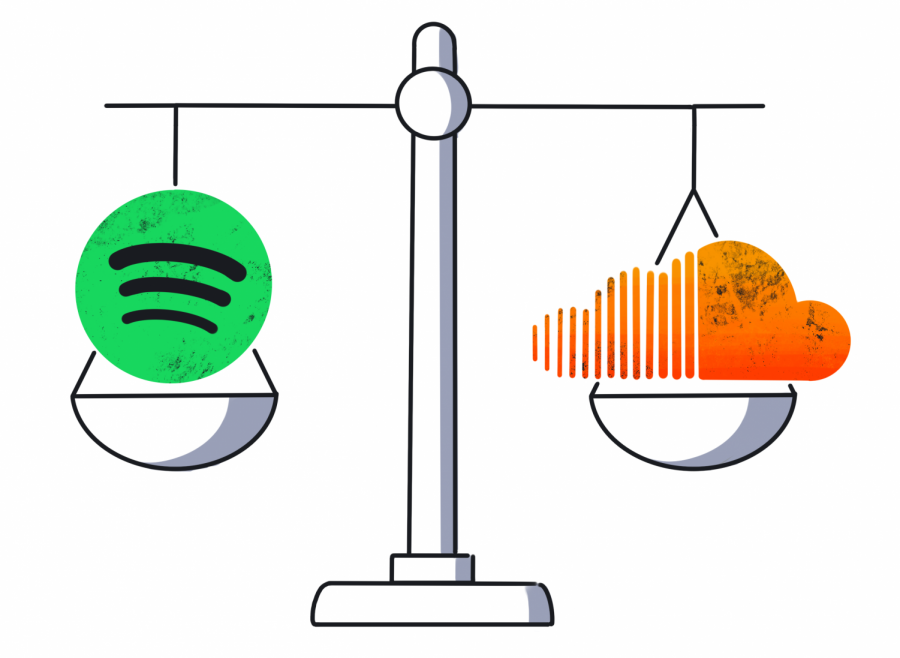Comparing Music Streaming Services
September 25, 2020
Every music streaming service has its advantages and disadvantages, and with the ever-growing number of choices, one might wonder which is best for them. Outlined below are some popular music streaming services along with distinct qualities, in no particular order.
Spotify
An adequate platform for the everyday listener, Spotify boasts a fair amount of attractive features. With over 50 million songs and over 700,000 podcasts, one will rarely struggle to find the song they are looking for.
There are two main plans: Spotify Free and Spotify Premium. The biggest differences between the two are that the free version has both audio and banner ads that appear in between songs. Additionally, music is streamed at 160 kilobits per second (kbps). The higher the Kbps, the better the quality of the digital music. Premium, on the other hand, has no ads and streams music at 320 kbps. The standard cost of Premium membership is $9.99 dollars per month. Premium users also can download songs onto the app for offline streaming.
Users can also create and share their playlists with others or listen to playlists that Spotify has created for them, allowing users to discover new music and further cultivate their music preferences. People can also follow popular artists as well as their friends, just by looking up their username. A partnership between Spotify and Genius, a popular song lyric website, has allowed users to display lyrics and other information about the song they are currently listening to. On Spotify’s desktop app, users can play M4P, MP3, and MP4 audio files that are stored on their computer.
Although the constant audio ads can be irritating for some Spotify Free users, Spotify is sufficient for the everyday, on-the-go user who simply wants to casually enjoy some music or podcasts.
SoundCloud
With a greater emphasis on content creators, this platform is for new artists. SoundCloud is particularly known for its social networking aspect, allowing users to share their thoughts by adding comments on the song.
Some additional features include tailored playlists, similar to Spotify. Users can also explore hashtags, such as #rap or #jazz, allowing the listener to find related genres or similar music.
Users can choose between SoundCloud Free, SoundCloud Go for $4.99 per month, or SoundCloud Go+ for $9.99 per month. SoundCloud Free streams at 128 kbps with up to 256 kbps for paid versions, and also has the ability to skip between songs or to specific areas in the song although not without occasional ads. SoundCloud Go removes ads and allows for an offline listening option. Unfortunately, the greatest downside is that unless you have SoundCloud Go+, you are unable to listen to a lot of major-label music. This leaves Free and Go users to have to listen to covers that were uploaded by other users. This blend of user creations and official music might leave the listener frustrated.
While there aren’t any game-changing features, the platform is perfect for listeners who want to discover new artists or for creators who want to share their music or podcasts with the world.
Apple Music
Unlike other music streaming services, Apple Music does not have a free version. A standard membership costs $9.99 dollars per month. While it is available for Android users as well, there are some features that are not accessible to non-Apple users.
Along with a catalog of over 60 million songs and podcasts, users can upload up to 100,000 songs to their iCloud Music Library and can listen to it wherever. The only limitations are that a song cannot be over 200 MB in size, which is very reasonable given that on average, a song is three to four MB. Some additional features include music videos and lyrics as well as Siri and Apple Watch integration. Lastly, all music is streamed ad-free at 256 kbps.
Apple Music is also known for its wide range of radios, especially its Beats 1 Radio, a human-curated, 24/7 radio channel from Apple. Users can utilize radios to find similar music or delve into a new genre or artist.
While the platform does not have any especially appealing features, it certainly does its job in providing a way for listeners to play almost whatever they like. However, non-Apple users might want to consider investing in another music streaming service.
Pandora
This is the ideal streaming service for someone who is willing to learn more about the music they are listening to.
Users can choose between a free version, Pandora Plus which costs $4.99 dollars per month, or Pandora Premium which costs $9.99 dollars per month. Like many premium versions of a music streaming platform, premium users can have ad-free personalized music and offline listening.
Pandora gives its users features such as lyrics, song credits, artist information and Pandora Stories, a tool that lets artists and creators add voice commentary and context to their playlists or albums. Pandora is also known for its Music Genome Project, which uses over 450 attributes and a complex mathematical algorithm to organize music. These attributes are listed out in some songs as bullet points. For example, when listening to the song “Stars” by Hum, users will find that the song is described as having “hard rock roots,” “major key tonality,” “punk influences” and “subtle use of vocal harmony.” While this feature might not be incredibly revolutionary, it not only adds some insight as to what a song might sound like before even clicking on it, but it also allows the listener to distinguish what they might like or don’t like about it.
The only significant disadvantage of using Pandora is its lack of high-resolution music. Pandora streams at 128 kbps for free users and 192 kbps for Premium users. This is considered subpar given that many premium memberships for other streaming services allow users to stream music at 256 kbps. Additionally, to listen to music, free users must manually click on a video advertisement. If you find that advertisements are bothersome, the ad-free Pandora Premium might just be worth the cost.
Tidal
Arguably with the most high quality and exclusive content, Tidal is for the heavy audiophile and die-hard music fan. Similarly to Apple Music, there is no free version of the platform. Users can choose between Tidal Premium which costs $9.99 dollars per month and Tidal HiFi, which costs $19.99 dollars per month.
One of the most notable things about Tidal is its music quality, with access to music at 1411 kbps or even 9216 kbps for those willing to pay for Tidal HiFi.
The platform has a wide range of features such as feature-length editorial pieces, curated playlists, video content, early access to concert tickets, concert live streams, exclusive albums, access to meet-and-greets, offline listening and even backstage content. Tidal’s exclusive video content consists of music videos, music video outtakes and exclusive sneak peeks. Additionally, some notable examples of albums that were released early include Jay-Z’s 4:44, Kanye West’s The Life of Pablo and Rihanna’s Anti. Unlike many music streaming services, however, Tidal does not offer lyrics for the listener.
While the premium version includes unique features, nothing is more impressive than the audio quality that HiFi users receive. For the casual listener, however, the relatively high cost of Tidal HiFi might be unnecessary.



![AAAAAND ANOTHER THING: [CENSORED] [REDACTED] [BABY SCREAMING] [SIRENS] [SILENCE].](https://thehowleronline.org/wp-content/uploads/2025/06/lucy-1200x800.jpg)
















































![AAAAAND ANOTHER THING: [CENSORED] [REDACTED] [BABY SCREAMING] [SIRENS] [SILENCE].](https://thehowleronline.org/wp-content/uploads/2025/06/lucy-300x200.jpg)



